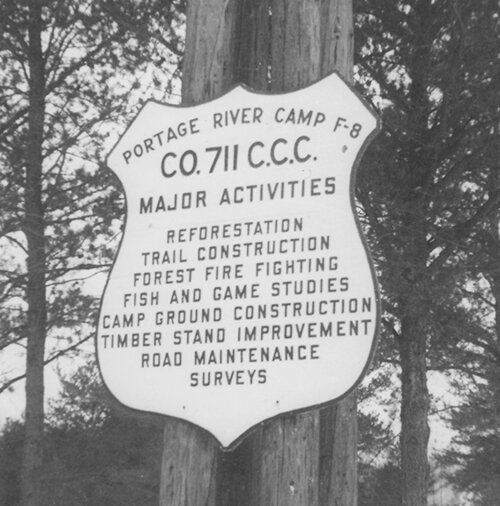Support the Timberjay by making a donation.
The Civilian Conservation Corps
North on the Echo Trail or northeast of town towards the North Shore, are some newer groves of pine—too young to be virgin timber but looking ready to be logged. These trees were likely planted …
This item is available in full to subscribers.
Attention subscribers
To continue reading, you will need to either log in to your subscriber account, or purchase a new subscription.
If you are a current print subscriber, you can set up a free website account and connect your subscription to it by clicking here.
If you are a digital subscriber with an active, online-only subscription then you already have an account here. Just reset your password if you've not yet logged in to your account on this new site.
Otherwise, click here to view your options for subscribing.
Please log in to continue |
The Civilian Conservation Corps
North on the Echo Trail or northeast of town towards the North Shore, are some newer groves of pine—too young to be virgin timber but looking ready to be logged. These trees were likely planted by the Civilian Conservation Corps (CCC). The CCC was developed by President Franklin Roosevelt as part of his New Deal during the Great Depression. He was extremely concerned about forest fires and the restoration of forest lands. CCC men planted more than three billion trees, as well as building trails and shelters in 800 parks, and established 700 new state parks during the nine years of the program.
By 1933, the Great Depression had already crippled the nation: unemployment was at an all-time high. In the Ely area, the mines were either closed or operating on a much-reduced schedule. Some residents tried to survive by gardening, fishing, and hunting—or even poaching. Immigrant families were especially reluctant to apply for government relief.
The CCC not only addressed Roosevelt’s concerns of conservation and firefighting, but it also provided employment for young men. Each man earned $30 a month, of which $25 was sent to their families. The other $5 covered candy bars, cigarettes, pop, and beer.
By July 1933, 1,433 working camps were established across the country with a number in northeastern Minnesota.
Basic education, such as reading skills, and vocational training were offered at some camps. This included forestry, typing, surveying, spelling, letter writing, mechanics, forging, carpentry, mapping, music, dancing, use of a slide rule, photography, public speaking, and various sports activities. Some young men learned enough to graduate from high school. Both Protestant and Catholic services were conducted each week, but attendance was voluntary. Weekend dances and weekend passes were frequent.
At the start, the CCC had to build housing and other necessary buildings had to be built. The first shelters were tent camps. Permanent dormitories, mess halls, recreation halls, and other structures were constructed with logs harvested from the forests. Other buildings were constructed with purchased lumber. Drilled wells provided drinking water even though the camps were often located near lakes.
The enrollees were mostly young, unskilled, and unemployed men between the ages of 18 and 25. Leaders in the camps were army officers and locally experienced men, known as LEMs. Clothing came from surplus supplies from WWI. Enrollees were also given underwear, shoes, coveralls, army fatigues, hats, rain gear, mosquito netting, army cots, and blankets.
Each man was obligated to serve for a minimum of six months. Most stayed longer. While the program did last for nine years, by 1942 men were needed for serving in WWII. More than 2,500,000 were enrolled in various places around the country. Actors such as Walter Matthau and Raymond Burr were CCC enrollees, as were Stan Musial and Chuck Yeager, the famous pilot.
Thousands of acres of forest lands had earlier been logged or burnt. The trees that the CCC planted are a living monument to the work of these men.
Camps in this area included #701 at McDougall Lake, #704 at Halfway, #711 on the Echo Trail, and #707 at Cutfoot Sioux. Camp #702 was located near Bena. Other camps included in Minnesota were Portage River, Cold Springs, Dunnigan, and Baptism River.
Years after the CCC folded, Kathy Kainz, a local forest service employee, interviewed some of the local men. The following are a sample of the transcribed interviews on file at the Ely-Winton Historical Society:
As an example of one of those interviews, LEM Uno Saari thought overall that FDR did well, especially with the CCC. “We had to build roads with picks, shovels, wheelbarrows, and a team of horses.” Later on, they got a caterpillar tractor. “We worked on road construction and tree planting... (There was) boxing, a library, basketball, and baseball...Parents came out a lot.”
The CCC effort gave many young men a boost when they needed it. The families of these men were better off during the Depression years because of it.
For more details, see J. C. Ryan’s “The CCC and Me.” Copies are available at the Ely-Winton Historical Society Office at the Vermilion Campus of Minnesota North College. An exhibit of pictures from the CCC is now on display in the Fine Arts Lobby. The summer hours for the office and the museum are noon until 4 p.m., Tuesday through Saturday.









